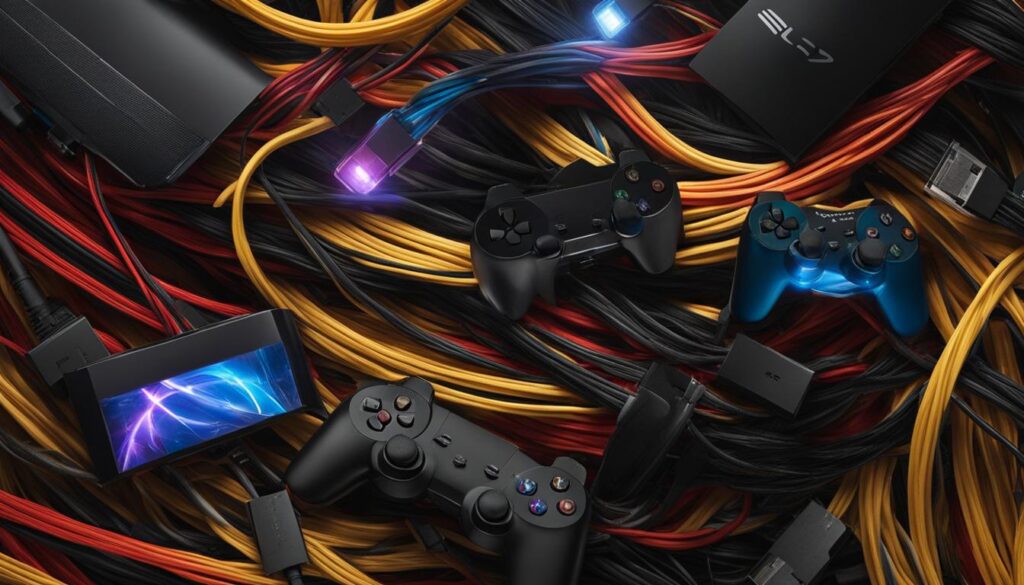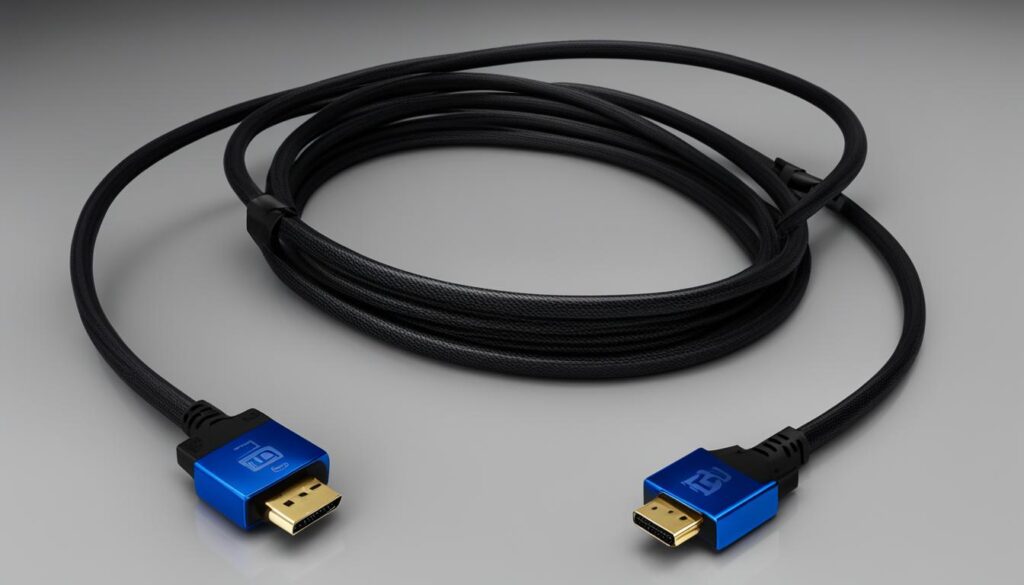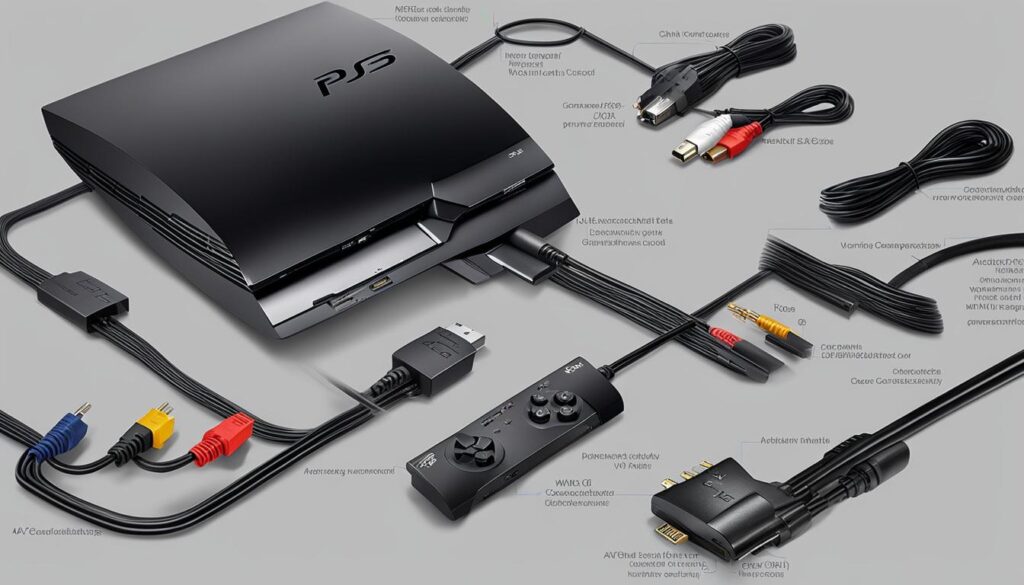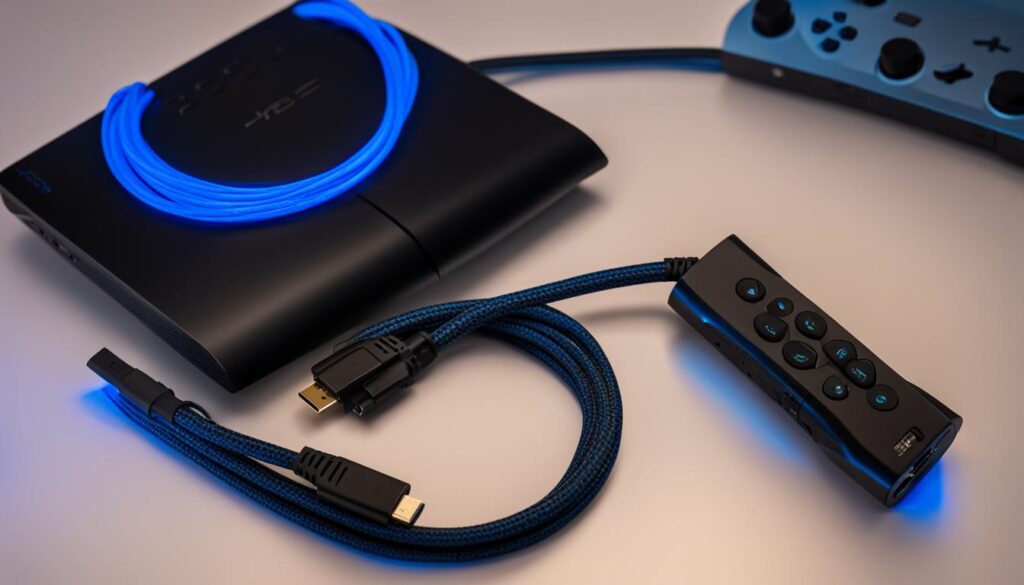Are you gearing up for a gaming session on your beloved PS3? You might be pondering whether you need a special HDMI cable to dive into your favorite titles. Worry not! The truth is, for your PS3, any high-quality HDMI 1.3 or HDMI 2.0 cable will serve you well, ensuring you get the best possible audio and video performance without any unnecessary spending. While PS3 doesn’t generally come bundled with an HDMI cable, the standard one that fits both PS3 and PS4—a “High-Speed” HDMI or one labeled with “High-Speed HDMI with Ethernet”—is just what you need for that immersive gaming grind.
So, before you scramble online or rush to the nearest store for an HDMI 2.1 cable and spend more than you need, let this guide bring clarity. After all, HDMI cables are about compatibility and performance, not just the price tag or latest version number.
Key Takeaways
- HDMI 1.3 or HDMI 2.0 cables are perfect for the PS3’s capabilities.
- Pricey HDMI 2.1 cables won’t enhance your PS3 gaming experience.
- Look for cables labeled “High-Speed” to ensure they support up to 1080p resolution.
- No need to splurge on expensive cables—a quality cable at a reasonable price is your best bet.
- Any standard HDMI cable will fit and work with your PS3, just as it does with a PS4.
Understanding the PS3’s HDMI Capabilities
If you’re dusting off your PS3 or are a steadfast user, it’s critical to understand the HDMI capabilities of your console. While technology has advanced rapidly, with HDMI standards evolving from 1.3 to the eye-popping 2.1, you don’t need to scramble in search of the latest HDMI cable. It’s important to note that the diminutive yet powerful PS3 was designed with HDMI 1.3 support, which delivers up to 1080p video resolution and high-quality audio transmission suited to its hardware capabilities.
It is reassuring to know that you can interchange HDMI cables between the PS3 and PS4 without any hiccups as they share the same size and shape for the HDMI socket. Whispers and worries about the need for a ‘special’ HDMI cable for your PS3 are unfounded. HDMI 2.0, highly touted for its enhanced video and audio features, might seem like an attractive upgrade. Still, it’s geared toward consoles optimized for 4K—something well beyond what the PS3 can output.
- PS3 supports HDMI 1.3 with full capabilities.
- No need to invest in HDMI 2.1 for PS3 use—a quality HDMI 1.3 or HDMI 2.0 cable will do just fine.
- Cross-compatibility with PS4 HDMI cables provides convenience and cost savings.
So, what’s the bottom line? Although your PS3 won’t leverage every bell and whistle of HDMI 2.0 forms, such as 4K visuals, it cozies up perfectly to the HDMI 1.3 standard. You’ll encounter no issues in performance when connecting it to a TV that accepts HDMI, even if that TV sports the later HDMI 2.0 ports. Why? Because backwards compatibility is a core feature of HDMI cables, and your PS3 will happily display its fine graphics through either an HDMI 1.3 or 2.0 cable.
Ensure you’re privy to the following table showcasing the HDMI specifications relevant to your PS3, bearing in mind that while newer standards appear more robust, they aren’t a necessity for your tried and true console:
| HDMI Version | Bandwidth Capabilities | Max Resolution | Suitable for PS3 |
|---|---|---|---|
| HDMI 1.3 | 10.2 Gbps | 1080p | Yes |
| HDMI 1.4 | 10.2 Gbps | 4K @ 30Hz | Overqualified |
| HDMI 2.0 | 18 Gbps | 4K @ 60Hz | Overqualified |
| HDMI 2.1 | 48 Gbps | 8K @ 60Hz | Unnecessary |
In conclusion, your PS3 doesn’t demand the latest or most expensive HDMI cable. Stick to a high-quality HDMI 1.3 or 2.0 cable, and you’re going to witness the full visual and auditory potential your PS3 has to offer. After all, it’s all about enjoying the gaming experience without being steered towards an unwarranted gear upgrade.
Picking the Right HDMI Cable for Your PS3
When prepping your PS3 for that epic gaming marathon, the last thing you want is subpar picture quality or delayed audio to ruin the experience. To ensure that doesn’t happen, choosing the correct HDMI cable is pivotal. But fret not, this task is less daunting than it seems. Remember, what you’re looking for is a cable that matches the PS3’s specs—1080p video and high-definition sound without the fluff that won’t affect your gaming.

Key Features to Look for in an HDMI Cable
You might ask yourself, why not just pick any HDMI cable off the shelf? While the PS3 can handle up to HDMI 1.3b, not all HDMI cables are created equal, and some might not provide the lush audiovisual experience you expect. If you spot a cable that boasts “High-Speed” or “High-Speed HDMI with Ethernet,” you’re on the right track. These pals can jump hurdles up to 1080p resolution—the PS3’s sweet spot.
- HDMI 1.3 or HDMI 2.0 label ensures compatibility with PS3.
- Cables indicated as “High-Speed” are specifically crafted for advanced transmission, providing smoother visuals and sound.
- Avoiding “standard HDMI” is key, as these may not support 1080p, leading to compromised gaming experiences.
- True Blue or Redmere cables are known for their reliable signal transfer over longer distances without signal loss or latency.
Comparing HDMI 1.3 and HDMI 2.0 for PS3 Use
Is HDMI 2.0 an overkill for the PS3? Absolutely. The PS3’s HDMI 1.3b output was quite the marvel for its time, handling 1080p like a dream. While HDMI 2.0 cables have waltzed onto the scene offering fancy features like 4K resolution, your PS3 couldn’t care less. It’s all dressed up with nowhere to go. So, a trusty HDMI 1.3b cable is all you need to unlock your PS3’s full potential.
| Feature | HDMI 1.3 Capabilities | HDMI 2.0 Capabilities | Relevance to PS3 |
|---|---|---|---|
| Maximum resolution | 1080p | 4K @ 60Hz | Perfect fit |
| Audio return channel (ARC) | Not supported | Supported | Not required for PS3 |
| Bandwidth | Up to 10.2 Gbps | Up to 18 Gbps | Exceeds PS3’s Needs |
In the long run, your best investment for a no-regrets PS3 gaming experience is to go for an HDMI cable labeled “High-Speed.” There’s no need to break the bank on the glittering allure of HDMI 2.0. Stick with the right specs, and rest easy knowing you’ve picked the winning cable for your PS3’s marathon gaming sessions.
Are Expensive HDMI Cables Worth the Cost for PS3?
When it comes to outfitting your PS3 with the right HDMI cable, you might wonder if shelling out for a pricier option will give you a better gaming experience. Well, pull up a chair and let’s talk signal transmission. Because HDMI carries a digital signal, it serves up your gaming highs and lows in a language of ones and zeroes. This digital nature means the audio and visuals either make it to your screen and speakers in pristine condition or don’t make it at all. There’s really no middle ground where a costlier HDMI cable could add some secret sauce to improve picture or sound quality.

So, before you part with more cash than you need to, consider this: Any HDMI cable capable of supporting up to HDMI 1.3 is all your PS3 requires to deliver its full graphical and auditory glory. Below, you’ll find a simple guide outlining the types of HDMI cables and their capability to carry the necessary signals for the PS3. Spoiler alert: Even the modestly priced ones have got you covered.
| HDMI Cable Type | Signal Support | PS3 Compatibility | Average Cost |
|---|---|---|---|
| Standard HDMI | 1080i, Not Ideal for PS3 | Not Recommended | $ |
| High-Speed HDMI (1.3) | 1080p, Perfect for PS3 | Yes | $$ |
| High-Speed HDMI with Ethernet (1.4) | 1080p and 3D Support, Overqualified | Yes, But Not Necessary | $$ – $$$ |
| Premium High-Speed HDMI (2.0) | 4K, Exceeds PS3 Requirements | Yes, But Unnecessary | $$$$ |
| Ultra High-Speed HDMI (2.1) | 8K, Highly Exceeds PS3 Requirements | Yes, Completely Unnecessary | $$$$$ |
To wrap it up, rest easy knowing that your PS3 will perform spectacularly with a High-Speed HDMI cable that won’t burn a hole in your wallet. Avoid the temptation of splurging on an Ultra High-Speed HDMI cable simply because it’s the newest kid on the block. Stick with what works—your gaming experience won’t miss a beat.
Alternative Connections: Beyond HDMI for PS3
When it comes to connecting your PS3 to your TV, HDMI isn’t the only path you can travel down. Believe it or not, there’s a whole world of alternative connections out there, ready to link up your console to various TV sets—especially those nostalgic, older models that might be lacking an HDMI input. These good old connectors have stood the test of time and continue to provide reliable video and audio quality for your PS3 gaming sessions.
Let’s explore the three amigos of non-HDMI connections—RCA Composite, RCA Component, and Euro-SCART RGB cables—with a special note that the latter is particularly popular across Europe. With these options at your disposal, you’re ready to tackle any TV input scenario, ensuring that your PS3 never collects dust, even if it’s not matched with the latest display tech.

- RCA Composite cables: These are your colorful team of three—yellow for video, red for right audio, and white for left audio. They’re the old-school heroes of connection, ready to deliver standard definition goodness.
- RCA Component cables: Step it up a notch with these cables, which include red, blue, and green connectors for video, plus red and white for audio, offering you enhanced video quality up to 1080i.
- Euro-SCART RGB cables: A staple in European homes, this single connector makes it a breeze to plug and play, delivering great video and audio without a fuss.
Now, to give you an even clearer picture, let’s break these down in a table for an apples-to-apples comparison:
| Connection Type | Video Quality | Audio Channels | Note |
|---|---|---|---|
| RCA Composite | Standard Definition | Stereo | Widely compatible with older TVs |
| RCA Component | Up to 1080i | Stereo | Better video quality, still compatible with many TVs |
| Euro-SCART RGB | Standard to Enhanced Definition | Stereo | Common in European markets |
Whether your TV is a blast from the past or a transitional tech piece, these connection methods ensure you can still enjoy the vast library of PS3 games. Each of these cables might speak an older language of tech, but they translate perfectly well into hours of gameplay joy and nostalgia. Don’t let a missing HDMI port put a pause on your gaming—grab one of these trusty cables and press play.
Maximizing PS3 Gaming with the Proper HDMI Cable
As a PS3 enthusiast, you know that the quality of your HDMI cable can make or break your gaming session. To ensure you’re getting the Full HD experience your PS3 games were designed for, you’ll need the right HDMI cable—one that supports 1080p quality. Not all cables are up to the task, so it’s important to select one that can handle the best your PS3 has to offer. Let’s dive into what makes an HDMI cable suitable for your console.

Ensuring Full HD Quality for Optimal Gaming Experience
The essence of PS3 gaming lies in its ability to deliver Full HD graphics, which means your HDMI cable must transmit visuals at 1080p resolution. A “High-Speed” HDMI cable is exactly what you need to see your games as they were meant to be seen—with vibrant colors, sharp images, and without any latency that could hamper your gameplay.
Moreover, ensuring your HDMI cable supports high refresh rates is critical for more than just competitive gaming. Even if you’re exploring vast open worlds or engrossed in a story-driven RPG, the right HDMI cable can provide a more fluid and immersive experience. But how do you know if your cable can deliver?
- A “High-Speed” label indicates the cable can handle 1080p content easily.
- If your cable is marketed as compatible with 4K, it’s more than capable of meeting your PS3’s requirements.
- For extended setups, active HDMI cables with built-in amplification can prevent signal loss over longer distances.
Here’s a quick comparison of different HDMI cable types to guide you:
| Type of HDMI Cable | Max Resolution | Refresh Rate Support | Best Use Scenario |
|---|---|---|---|
| Standard HDMI | 720p/1080i | 60Hz | Not recommended for PS3 |
| High-Speed HDMI | 1080p | Up to 120Hz | Perfect for PS3 gaming |
| Premium High-Speed HDMI | 4K/60Hz | Up to 240Hz at 1080p | Overqualified for PS3, but future-proof |
| Ultra High-Speed HDMI | 8K/60Hz | Up to 120Hz at 4K | Not necessary for PS3, but ideal for latest consoles |
Remember, the goal is to match the cable to your console’s capabilities. Your PS3 will never require more than 1080p at 60Hz, so while it’s okay to “over-qualify,” it’s not necessary. A High-Speed HDMI cable is just right to deliver the Full HD performance you seek for an unforgettable PS3 gaming marathon.
Common HDMI Cable Issues with the PS3 and How to Solve Them
Encountering an issue with HDMI connectivity on your PS3 can be a real mood dampener, especially when you’re all set for a gaming session. But before you let frustration get the better of you, let’s troubleshoot some common HDMI cable issues together. Most problems can be rectified with a few simple checks and adjustments, so roll up your sleeves, and let’s get your game back on track.
Checking HDMI Port Integrity
First things first, your PS3’s HDMI port is a critical link in the chain. A common culprit for connectivity woes is the presence of loose or broken pins. This can occur due to frequent plugging and unplugging of the HDMI cable or accidental stress on the port itself.
- Inspect the HDMI port on your PS3 and your TV or monitor for any visible signs of damage. If you spot any bent or broken pins, that could be the root of your problem.
- If the HDMI port on your PS3 looks suspect, try connecting to an alternate HDMI port on your TV if available.
Securing HDMI Cable Connections
A loose HDMI cable connection can often result in audio disruptions or a complete loss of video signal. Ensuring a snug fit can sometimes resolve these problems instantly.
- Double-check that the HDMI cable is firmly connected to both the PS3 and your display device. It should fit securely without any wiggle room.
- Consider using a cable clip or tie to manage excess cable length and prevent unwanted stress on the connectors.
Restarting Devices
If adjusting the physical connections doesn’t help, the old tried-and-true method of “turning it off and back on again” can work wonders. This basic step can reset a quirky HDMI handshake issue between your PS3 and the display.
- Power down your PS3 and the connected TV or monitor.
- Disconnect the HDMI cable, wait for a minute, then reconnect it ensuring a firm connection.
- Power back up both the PS3 and the display device and check for proper audio and video signal.
If these steps don’t solve the problem, consider trying a different HDMI cable to rule out the possibility of a faulty wire. Remember, when it comes to your PS3, sticking with a High-Speed HDMI cable (1.3 or 1.4) is sufficient, so there’s no need for the fancier HDMI 2.0 or 2.1 versions for gaming. Here’s a quick look at the various HDMI versions and their suitability for your PS3:
| HDMI Version | PS3 Compatibility | Suitable for Repair/Replacement? |
|---|---|---|
| HDMI 1.3 | Yes | Highly Recommended |
| HDMI 1.4 | Yes | Recommended |
| HDMI 2.0 | Yes, but Overqualified | Not Necessary |
| HDMI 2.1 | Yes, but Highly Overqualified | Overkill |
With a bit of patience and the right approach, most HDMI issues on your PS3 can be solved, ensuring that you get back to gaming bliss without missing a beat. So next time you power up your PS3 and something seems amiss, refer back to these steps and conquer those HDMI gremlins!
Is Your HDMI Cable Future-Proof? PS3 and Beyond
Whether you’re a dedicated PS3 player or considering an upgrade to the latest consoles, it’s worth asking if your HDMI cables can stand the test of time. As you delve into higher resolutions and more sophisticated gaming systems, the last thing you want is for your HDMI cable to fall short. But, good news—your trusty HDMI cables for PS3 are designed for longevity and broader applications, embracing backward compatibility as a core standard. This means that the HDMI 1.4 cables which serve your PS3 well are also ready to connect to TVs and monitors featuring HDMI 2.0 ports without a hitch.
Upgrading from PS3: Will Your HDMI Still Work?
Upgrading your gaming setup is always thrilling, but it typically comes with the worry of needing new accessories. This is where HDMI’s backward compatibility shines. Say you decide to move from your PS3 to a more recent device—you’ll be pleased to know that your existing HDMI cables can likely jump from your old console to the new one without any compatibility issues. The cables are ready to handle newer HDMI standards like 2.0 and even 2.1, ensuring that they don’t become obsolete anytime soon.
For peace of mind, here’s a comparative look at the HDMI versions and their compatibility with your tech arsenal:
| Your Console | HDMI Cable Used | Compatibility with HDMI 2.0 Ports | Compatibility with Future Devices |
|---|---|---|---|
| PS3 | HDMI 1.4 | Fully Compatible | Likely Compatible with Certain Limitations |
| Upcoming Consoles | HDMI 1.4* | Fully Compatible | Fully Compatible with HDMI 2.0 and Some Features of 2.1 |
| Latest TVs/Monitors | HDMI 1.4 | Fully Compatible | Works but May Not Support All New Features |
*Please note that while HDMI 1.4 cables will plug into upcoming consoles, they may not support the highest display resolutions or refresh rates these new devices may offer. It’s all about the right balance between your needs and what’s on offer.
Remember, a future-proof setup isn’t about chasing the latest cable; it’s about understanding the interplay between your devices and cables. Your current HDMI cable might just be the trusty bridge between your beloved PS3 and the stunning graphic capabilities of future gaming adventures.
Final Thoughts: Making the Right HDMI Choice for Your PS3
As you gear up for your next epic PS3 gaming session, the HDMI cable conundrum need not distract from your quest for virtual triumph. Take comfort in knowing that your PS3 setup does not demand the extravagances of the latest HDMI technology. A dependable HDMI 1.3 or 2.0 cable suffices for transferring those heart-pounding visuals and spine-tingling sounds, ensuring you reap the full immersive benefits your games offer, all without the sting of overspending.
Wise are those who choose function over flair, especially when it involves tech peripherals. Save your hard-earned dollars and bypass the marketing jargon that glorifies the most recent versions with high-flown specs irrelevant for your venerable PS3. Instead, hone in on cables that align with your console’s needs—robust and economical options that promise compatibility and resilience for sessions today and for gaming escapades yet to come.
Ultimately, the HDMI cable that bridges the gap between your PS3 and TV isn’t about keeping up with the Joneses; it’s about tailor-fitting the cord to the console, providing a seamless blend of old-school gaming with modern functionality. So rest assured, you’re well-equipped with the necessary insights to clinch the deal on an HDMI cable that will serve you faithfully, time and time again.
